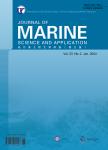Challenging Problems on Ventilated Cavitation and Paths to Their Computational Solutions
关于通气空泡及其路径数值求解的挑战性问题(英文)作者机构:Mechmath LLC
出 版 物:《Journal of Marine Science and Application》 (船舶与海洋工程学报(英文版))
年 卷 期:2019年第18卷第3期
页 面:260-270页
核心收录:
学科分类:12[管理学] 1201[管理学-管理科学与工程(可授管理学、工学学位)] 0707[理学-海洋科学] 08[工学] 0815[工学-水利工程] 0824[工学-船舶与海洋工程] 0802[工学-机械工程] 0801[工学-力学(可授工学、理学学位)]
主 题:Ventilated cavitation Computational fluid dynamics Lift, drag, and air demand of cavitating bodies Shockwaves in cavities
摘 要:Ventilated cavitation has been successfully employed as ship drag reduction technology and potentially can mitigate flowinduced vibration. The obtained successes were based on solutions of design problems considered in the framework of ideal fluid theory with their following validation by towing tank tests. However, various aspects of the interaction of ventilated cavities with the viscous flows around the ship hulls remain unclear, whereas there is usually no possibility to simultaneously keep the full-scale Froude number and cavitation number in the test facilities. So, the further progress of the application of ventilated cavitation substantially depends on the ability of computational tools to predict this interaction. This paper briefly describes the state-of-the-art computation of ventilated cavitation and points out the most challenging unsolved problems that appeared in the model tests (prediction of air demand by cavities, ventilation effect on ship drag, on hydrofoil lift, and on the propagation of shock waves in cavities).



